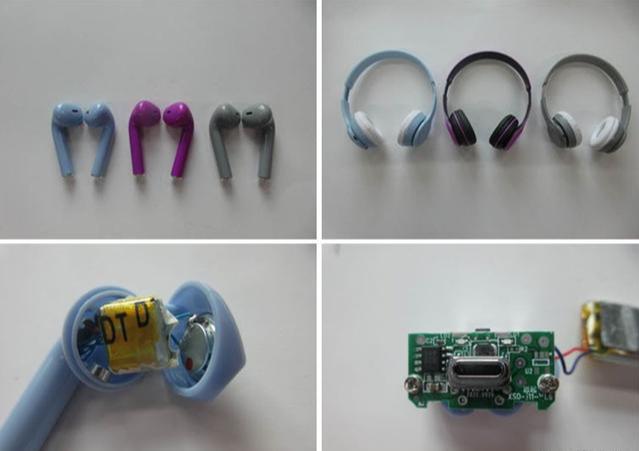As one of the most popular electronic products among the masses, the convenience and practicality of TWS earphones are self-evident. The inspection standard of Bluetooth headsets not only affects its experience but also affects the wearer's hearing and health problems. Therefore, the inspection of a wireless Bluetooth headsets is very important. The following are the inspection standards and methods of the third-party inspectors of the testing library for Bluetooth headsets.
Inspection standard and method for wireless Bluetooth headset
1. Inspection tools
Ruler, vernier caliper, plug gauge, comparison sheet, sample, barcode scanner, anti-static gloves or finger cots, dust cloth, alcohol, knife, sealing tape, clear tape (3M 600), a Bluetooth-enabled cell phone.
2. Inspection conditions
Temperature: 15-35℃;
Humidity: 20%-75%;
Atmospheric pressure: 86kPa-106kPa
Vision: The inspector's vision requirement is not less than 1.0 (including corrected vision);
Distance: The distance between the human eye and the surface of the mobile phone under test is 300mm±50mm;
Lighting: 40W fluorescent lamp (the light source is directly above the detector), the light source is 500mm-550mm away from the object to be tested, and the light intensity is 1000±200Lux;
Viewing angle: The product viewing surface and the desktop form a 45-degree angle, and rotate 45 degrees up, down, left, and right (as shown below):
3. Visual inspection
3.1 The appearance is free from scratches, poor painting, poor silk screen printing, mold marks, and burrs;
3.2 No variegated color, mildew, and rust;
3.3 The fuselage shall not be deformed, cracked, or damaged;
3.4 The shell gap is well matched, and there is no loose phenomenon;
3.5 Switches, control buttons, knobs, screws, etc. are free of defects;
3.6 Accessories such as ear caps, USB charging cables, etc. are in good condition;
3.7 There is no foreign matter in the fuselage.
4. On-site general project testing
4.1 Barcode scanning (outer box barcode);
4.2 Barcode Scanning (Sales Packaging Barcode);
4.3 Odor inspection (sales packaging);
4.4 Odor inspection (product);
4.5 Product size and weight;
4.6 Coating adhesion test
Use 3M 600 tape to test the adhesion of oil spray, hot stamping, UV coating, and printing surface, and the content cannot be 10% off;
4.7 Nameplate friction test
Wipe the logo or warning 15S with a cloth dipped in water, and then wipe the 15S with a cloth dipped in alcohol or gasoline, there is no obvious change on the nameplate, and the handwriting should be clear and not affect reading;
4.8 Speaker Impedance Test
Measure the impedance of the left and right channels of the earphone respectively, generally 8-32 ohms, and the impedances on the left and right sides must be the same;
4.9 Speaker Sensitivity Test/Frequency Response Test
Use the tester provided by the factory to test the sensitivity of the earphone speaker, and the frequency response of the speaker should meet the customer's specification requirements;
4.10 Battery voltage test;
4.11 LED indicator test
The response status of the indicator lights during the process of turning on, turning off, pairing, incoming calls, calls, charging, and full charging should be consistent with the specifications provided by the customer.
4.12 Internal workmanship test
Reliability of ground connection; effectiveness of power cord fixation; no cold welding, bad solder joints; no loose parts (switches, motors, controls, etc.); wire grooves should be smooth and free of sharp edges; no internal foreign bodies;
Wireless Bluetooth headset inspection-test library inspection

5. On-site functional testing
5.1 Power-on and power-off test
Press the multi-function button for more than 4 seconds, the headset should be able to automatically turn on and off;
5.2 Headphone pairing test
Press and hold the multi-function button, and the headset enters the pairing state, and can be paired with a Bluetooth mobile phone;
5.3 Headphone use function test
Detect the functions of the headset according to the instructions, such as answering calls, volume adjustment, voice dialing, button functions, intelligent induction, etc.;
5.4 Wireless Distance Test
After the headset is connected to the mobile phone, it should be able to use normally within 33 feet/10 meters (or according to the instructions);
5.6 Call Quality Test
The headset has no noise or echo during the call, the receiver has no "broken sound", and the headset has no obvious fever within 10 minutes of the call;
5.7 Charging function test
Using the corresponding charger, the headset can be charged normally, the display light is normal, and the body does not heat; the charging time reaches the specified time, such as 1.5 hours, the green light is on (indicating that it is fully charged).
6. Packaging and Components
6.1 The color and quantity on the package are consistent with the product list;
6.2 The size of the package is consistent with the packaging guidelines;
6.3 The color box/PVC bag is not damaged;
6.4 The surface printing is correct and there is no bad phenomenon;
6.5 The manual, warranty card, etc. are not missing or damaged.
QCANT™ Quality Control Service Provider,Partner of SGS,TUV,Intertek provide variety of professional inspection and auditing services with 180+ inspecters to ensure goods meet buyer requirements and regulations in the supply chains. QCANT Pricing begin with ALL included only $198/MD for Inspection in China, 5 minutes to make an online booking , get order scheduled and 99% receive report within 24 hours